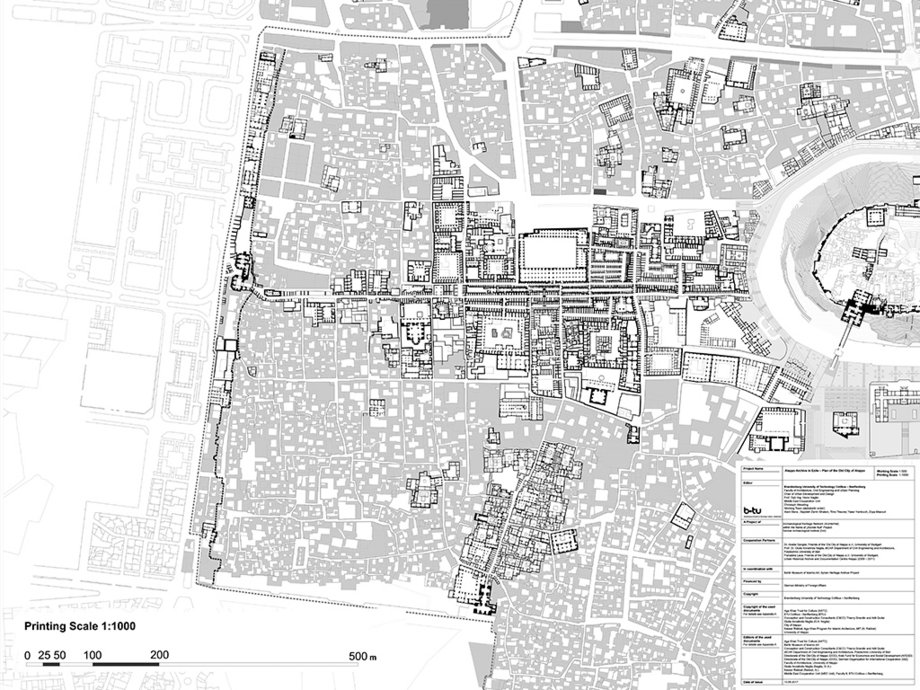Urban Cultural Heritage in the Middle East Old City of Aleppo
Five Thousand Years of Urban Structures
The Plan of the Old City of Aleppo shows the pre-conflict urban structure of the historic core of Aleppo and documents different layers of the unique morphological characteristics and exceptional spatial qualities of its Old City as it has developed over thousands of years. The distinctive structure of an ancient city complex and its later transformation into an old Arabic city with significant monuments and their squares, bazaars, main streets and various quarters with individual neighbourhoods along dead ends represents the unique characteristic, even if many buildings and streets are currently severely damaged.
Aleppo, as Syria’s second largest city and one of the oldest continuously inhabited settlements in the world, was dominated by armed conflict since the beginning of 2011 to the end of 2016. The extent of humanitarian loss and devastation of the cultural heritage soon reached the level that in 2013 the Old City of Aleppo was placed on the UNESCO list of the World Heritage in Danger.
Taking into account the richness of the Old City of Aleppo as a cultural palimpsest of various historic layers, the project of Aleppo Archive in Exile- Plan of the Old City of Aleppo was outlined. The project aimed at filling the gap in the existing documentations and analysis on the Old City of Aleppo through generating a comprehensive inventory of its pre-conflict urban structure in its totality and complexity as well as enhancing the urban values and integrity of the Old City.
The project integrated relevant existing urban investigations on the spatial structure of the Old City into a unified picture. For this purpose, Durrafour’s documentation efforts of the land register plans (cadastre) from 1928 to 1931 which had introduced a modern way of understanding the city through an accurate representation of the property structure, became highly instrumental. These plans, which were digitized in the late 90s by the ‘German Society for Technical Cooperation’ (GTZ, now GIZ) together with the Directorate of the Old City of Aleppo (DOC) and recently revised by the Berlin Museum of Islamic Art, were employed as the main base for the Plan of the Old City of Aleppo. The digital cadastral plan was overlaid with an inner courtyard plan of the Old City, making the built-up area more visible while further emphasizing on the morphological relationship between the masses and voids.
In order to enhance the overall picture of the urban structure, ground floor plans of numerous individual buildings with high cultural significances were included in the Old City plan. These buildings represent the Old Aleppo’s most valuable architectural and urban elements such as traditional houses, mosques, madrasas, hammams, khans, suqs, the citadel and even newly designed public spaces. Moreover, the plan illustrates the destruction and transformation of some of the parcels during the modernization period and at the same time reveals structures that are currently hidden by building rubbles. Where today only rubble is visible, the plan shows the foundation walls, paths, alleys and parcel structures underneath. The 1984 inventories of the Old City prepared by Heinz Gaube and Eugen Wirth served as other important
reference documents to show morphological characteristics including the historic periods and the functions of the significant individual buildings within a more comprehensive image. Finally, the collected documents of the highly praised Rehabilitation project of the Old City of Aleppo (1990s to 2011) including the surveys, analysis and design proposals, were located on the Plan.
Each of these documents have recorded one or more aspects of Old Aleppo’s urban form pertinent to its morphology, pattern of the spatial components and its development processes which epitomize the social, cultural, economic, political and environmental forces of the city in the course of history. As a result, these valuable documents not only portray the physical characteristics of Aleppo’s architectural or urban elements but also narrate living patterns, structures, traditions and memories of the previous generations when put together in a detailed and comprehensive manner.
The scope and performance of the current project was drawn mainly based on the capacities provided through the long-term cooperation of the architects and urban planners of the BTU with the University of Aleppo regarding the development and revitalization of the World Heritage Site. After the outbreak of the armed conflict, BTU academics together with colleagues from other institutions took on the task of securing existing documents on the Old City of Alepp. The Plan of the Old City of Aleppo at hand with 16,000 parcels and around 400 ground floor plans, was the result of a close cooperation between BTU, Association of Friends of the Old City of Aleppo and University of Bari based on extensive and long standing academic and practical experience of each institute on the Old City of Aleppo. Finally, the project was carried out within the Archaeological Heritage Network for the preservation of cultural heritage and through a cooperative partnership with the Syrian Heritage Archive Project at the Museum of Islamic Arts in Berlin.
Plan of the Old City of Aleppo (37MB)
HerunterladenPlan of the Old City of Aleppo (4MB)
HerunterladenExhibition Posters (70MB)
HerunterladenExhibition Posters (16MB)
HerunterladenReferences & Copyrights - Plan of the Old City of Aleppo (1MB)
Herunterladen






